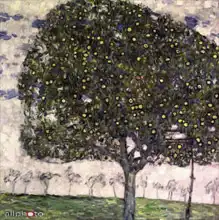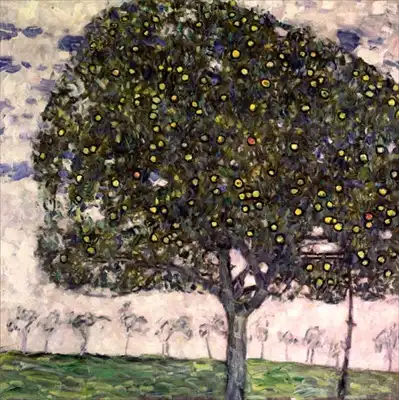About this finishing
Print. The image is printed on the top quality 10-ink HP Z9PS printer on HP matte 270 g / m2 paper. You can choose any size to an accuracy of 1 cm. A margin of 5 cm around the image is added to the size of the motif.


You can find a detailed description about our finishings
here.
Apple tree II
Date:
1916Medium:
oil on canvasLocation:
private collectionDimensions:
80 x 80Apple Tree II is one of
Klimt's three paintings depicting a tree festooned with apples. The oldest is the work Zlatá jabloň from 1903, which was unfortunately destroyed during a fire in 1942, followed by
Apple tree I , which is more colorful and positive than the third version. Although the symbolism that the apple trees carried for
Klimt's is hidden from us, it seems that they must have reminded him of something when he returned to this motif several times. Apple trees appear in a number of myths and legends, they remind Christians and Jews of the tree of knowledge from Paradise, and in Greek mythology the apple appears as a gift from Paris to Aphrodite or as an attribute of Heracles. Since the painting dates of these Klimt paintings are quite far from each other, it is likely that they did not have only one meaning for him.
Klimt painted picture Apple tree II in 1916. Prevailing color of this fine art print is vivid and its shape is square. Original size is 80 x 80. This art piece is located in a private collection This image is printed on demand - you can choose material, size and finishing.
Gustav Klimt (1862-1918). As a painter, Klimt represents the best period of Vienna – a time when the works of Sigmund Freud or Mahler were developing, and Vienna was at the very least the Central European centre of culture and education. Klimt’s work combines
symbolism and Byzantine features that create the undertone of his Art Nouveau style. Klimt’s images have a special, even anxious, atmosphere that often shows the Freudian idea of erotica in any human movement and action. Klimt paints two-dimensionally, with intense colour while at the same time very gently and with refined dignity. Among Klimt’s famous works are the
Water Snakes - two women with stylized, interwoven bodies that evoke the surreal world of fantasy and sensuality. Another masterpiece is
Danae, a work inspired by Greek mythology, depicting a girl seized by Zeus, who was turned into a golden rain (Danae later gave birth to Perseus). His paintings often aroused passions and public protests, not only for their content but also for the innovative painting methods - eg.
The Girlfriends, an image of two women at a romantic meeting.

